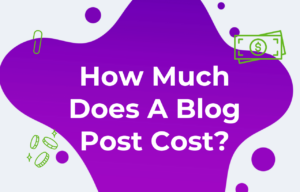
How Much Does A Blog Post Cost?
Have you ever wondered how much a blog post costs? Learn how much content is from various types of content writers in our latest blog post!
It’s time to address the elephant in the room.
Why did Nellie really pack her trunk and say goodbye to the circus?
You know what? That’s an issue for another day…
Instead, let’s look at the most talked-about movement in content marketing right now – AI-generated content.
These days, most blogs and social media posts you read seem to be about an AI copywriting tool or that AI-generated photo of the pope looking, quite frankly, very stylish in a white puffer.
With Microsoft investing billions of dollars in ChatGPT, we can’t deny that AI copywriting tools will be a pretty significant part of our industry’s future.
With 44% of marketers using AI to create content for them, you might be wondering if we (a team of professional copywriters and content writers) use AI writing tools to help us with ours.
It’s likely already apparent that this piece has been written by a human. (A moderately unhinged one, admittedly.)
If a bot was capable of writing precisely in our unique brand voice while making bizarre cultural references, we would be initially impressed, and then terrified afterwards.
We have found some uses for AI writing tools for sure, but that’s not to say we don’t have our issues with them.
So, let’s look at how we use AI copywriting tools to help our content and the ways we definitely big-fat-don’t.

We’ve found a few uses for AI in our copywriting to streamline our processes and optimise our workflow, which you might find helpful too:
Sometimes you’ve got a great idea for a blog, but you can’t quite decide on the right title name that hooks your reader in. Other times, you know broadly what topic you want to write about, but you don’t yet know what specific avenue you want to go down.
In these instances, AI copywriting tools are great for throwing a load of ideas your way that you can pick from and use as a springboard to create engaging, entertaining, and high-quality content.
Particularly useful when writing about a subject you’re unfamiliar with, AI tools can give you points to hit in blog posts and gently nudge you in the right direction.
Similarly, when writer’s block strikes, using AI copywriting tools to generate content can give you the inspiration you need to write your next great masterpiece.
When you spend your days writing content, you’ll inevitably miss the odd spelling mistake. While Google Docs has grammar and spell-check built in, it has its oversights too.
Using tools like Grammarly is a great way to ensure your content is free of silly mistakes and grammatical errors before publishing it online. It can also make your content more readable by highlighting unnecessary phrases clogging up your content.
Although, we do advise you to do this with caution! While it’s great at pointing out phrases that don’t add value to your existing content anyway, sometimes it asks you to make changes to your sentence that no longer makes sense in context. Always be sure to double-check everything AI tools are telling you to do.
Side note: The creator of the online Thesaurus deserves the Nobel Peace Prize for saving countless laptops from being thrown from a great height.

If you need to find public contact info for a client’s website or an information piece, you can use AI to find this information. It’s a great way to use an AI tool to save time and maintain your workflow so you can prioritise your writing tasks and do what you do best; creating awesome website copy.
Now for the hard truths about AI copywriting software. Robots, look away now.
When publishing content online, you want to be confident you’re using research you can trust. The only way to ensure the research you’re basing your content on is correct and comes from a reputable source is to find or verify it yourself.
AI makes a lot of assumptions and so can’t be trusted to produce ethical and reliably-sourced content. Many of the reference links AI tools supply almost always lead to a dreaded Error 404 page or are entirely irrelevant to your topic.
While AI copywriting software can be very useful in providing a rough guide and inspiration for a blog post, it can often miss crucial points that you’d otherwise leave out if you don’t cross-reference them with other blogs.
AI blog outlines are too vague, generic, and uninspiring for an audience. If you want to create engaging blogs that are well structured, easy to read, and provide real value to the reader, then don’t rely on AI to do that without your input and expertise.
When you work with us, you can relax knowing that a real-life experienced human writer is writing your content. This means your content will always be unique, engaging, and true to your brand identity! Yay, humans!
We don’t believe that AI-generated copy can ever be truly engaging. So here’s why we never let AI do the real work for us.
AI copywriting software is incapable of:
Google and other search engines know when you’re using AI-generated content for SEO, and the algorithm overlords won’t be happy with you if you don’t rework the content yourself (neither will your reader.)
Use an SEO tool to conduct local keyword research that you can naturally pepper throughout your blog posts. While hitting your keywords is essential to rank on Google, so is writing for humans, so make sure your content is easy to read and doesn’t appear spammy.

We can’t deny that AI copywriting tools have their uses and, in some instances, can make the writing process easier and eliminate human error in proofreading.
However, we don’t believe it will take over the future of copywriting entirely.
While it can be useful, it simply can’t do the same job as a human at the end of the day. It lacks all of the elements that make reading well-written content enjoyable and engaging, the things that draw your audience in and keep them coming back.
Want to work with our talented group of human content writers so you can create compelling content for your website, blog posts, landing pages, emails, and social posts that stands out from the crowd?
Get in touch, and let’s talk (to an actual human and not a chatbot) about your content needs. 🙂

Have you ever wondered how much a blog post costs? Learn how much content is from various types of content writers in our latest blog post!

It’s a really common question marketers hear all the time: do blog posts have a good return on investment? The answer is – yes! Find out why in our blog…

Get your audience engaged with content written for THEM. Here are our top tips for writing great content that connects & converts.